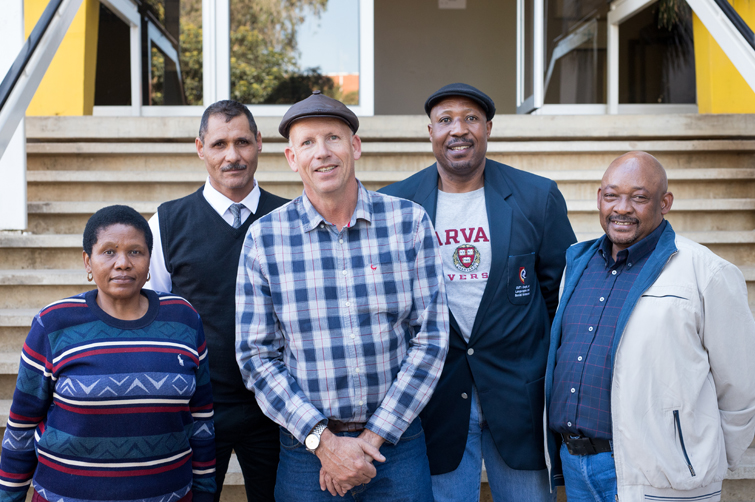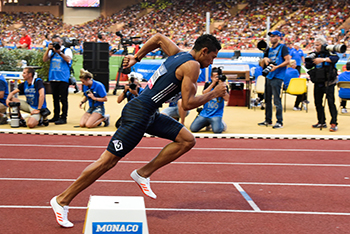Latest News Archive
Please select Category, Year, and then Month to display items
13 January 2020
|
Story Eugene Seegers
|
Photo Anja Aucamp
 Spearheading the digital expansion of the conversational Sesotho course is IDEAS Lab Director, Johann Möller (middle). With him are from the left: Prof Pule Phindane, CUT; Dr Brenton Fredericks, CUT; Bahedile Letlala, UFS Department of African Languages; and Dr Elias Malete, UFS Department of African Languages.
Spearheading the digital expansion of the conversational Sesotho course is IDEAS Lab Director, Johann Möller (middle). With him are from the left: Prof Pule Phindane, CUT; Dr Brenton Fredericks, CUT; Bahedile Letlala, UFS Department of African Languages; and Dr Elias Malete, UFS Department of African Languages.
For many years now, the UFS has been offering a one-year course in conversational Sesotho for staff members; this can then be followed up with the one-year course in advanced conversational Sesotho. The conversational Sesotho for students in the Faculty of Education was introduced in 2018 at the UFS.
The Central University of Technology (CUT) needed a conversational course for its first-year students and approached the Department of African Languages for the development of such a course. Living as we do in a multilingual country; this additional language skill opens doors and often hearts as well.
Using instructional design principles
However, the need was identified by both CUT and UFS to present this crucial information in a way that would be more appealing to digital natives as well as to those less familiar with technology. The Department of African Languages on the UFS Bloemfontein Campus, together with relevant departments from the CUT, approached the IDEAS Lab located on the UFS South Campus, since they already have a reputation for being a specialist on broadcasting and repackaging curricular content for digital presentations. The IDEAS Lab provided technical advice and built the multimedia programme, which will help the user to hear and practice phrases in Sesotho, using instructional design principles. The course will be available to both staff and students belonging to the two universities.
Room for growth
Johann Möller, Director of the IDEAS Lab, says this pilot programme will give both institutions the opportunity to test the use of multimedia for language acquisition. He adds, “Language is extremely complex, and we would like to expand this learning aid in the future.” In fact, the original design has room for growth built into it.
To keep things simple for the user and the building team, it was decided to start out with only four potential everyday scenarios where a staff member would like to speak Sesotho: Firstly, how to greet other persons from different genders; secondly, potential scenarios one might encounter in the university environment itself; thirdly, how to deal with situations at a hospital; and finally, how to use one’s language skills at a filling station.
Pronunciation is key
Each scenario contains three to four conversations that the learner can revise, along with images and audio that illustrate the situation and assist with correct pronunciation. The system does not allow the user to progress unless they have listened to the pronunciations of the sample sentences or phrases.
Further reading material and vocabulary lists are also provided, with the result that people who are using the programme can learn at their own pace. The authoring software Articulate Storyline was used to build the individual scenarios and each conversation or lesson within it. The lessons are also not dependent on an internet connection; they can be downloaded onto a flash memory drive and used offline.
Wayde claims gold and silver at IAAF World Championships in London
2017-08-11

The Olympic champion, Wayde van Niekerk, continued
his superb form over the past few months when he
won a gold medal in the 400 m and a silver in the 200 m
at the IAAF World Championships in London.
Photo: Getty Images
This is just the beginning. These were the words of an emotional Wayde van Niekerk after he completed one of the best weeks in his young career at the IAAF World Championships.
The 25-year-old Kovsie star claimed a gold medal in the 400 m in London, England, on 8 August 2017, and added a silver in the 200 m on 10 August 2017.
Furthermore, he was only 0.02 seconds away (in the 200 m) from achieving a 200 m/400 m double – something which was last done in 1995 at a World Championship by Michael Johnson. Van Niekerk won the 400 m in London in 43.98 s, and two days later his 20.106 s was enough for a silver in the 200 m. Ramil Guliyev from Turkey was first in 20.09 s.
Role model for Kovsie community
Once again Van Niekerk’s achievements warmed the hearts back home at the University of the Free State (UFS). “This is an extremely proud moment not only for the country, but in particular for the University of the Free State. Wayde is a role model for the entire Kovsie community, and we have been following his achievements in the international arena with great excitement. We are elated by his performances. Congratulations also to Tannie Ans and his management team,” Prof Francis Petersen, Rector and Vice-Chancellor of the UFS, said.
So much more ahead, says star
“I really feel I worked hard for tonight and I gave it my all. And I think I have proven over and over again I deserve what I have achieved. It was a tough week for me,” Van Niekerk said in an interview with the BBC. “I am glad that I could come out again today and put on a good fight. I really believe this is just the beginning of so much more I can achieve.”